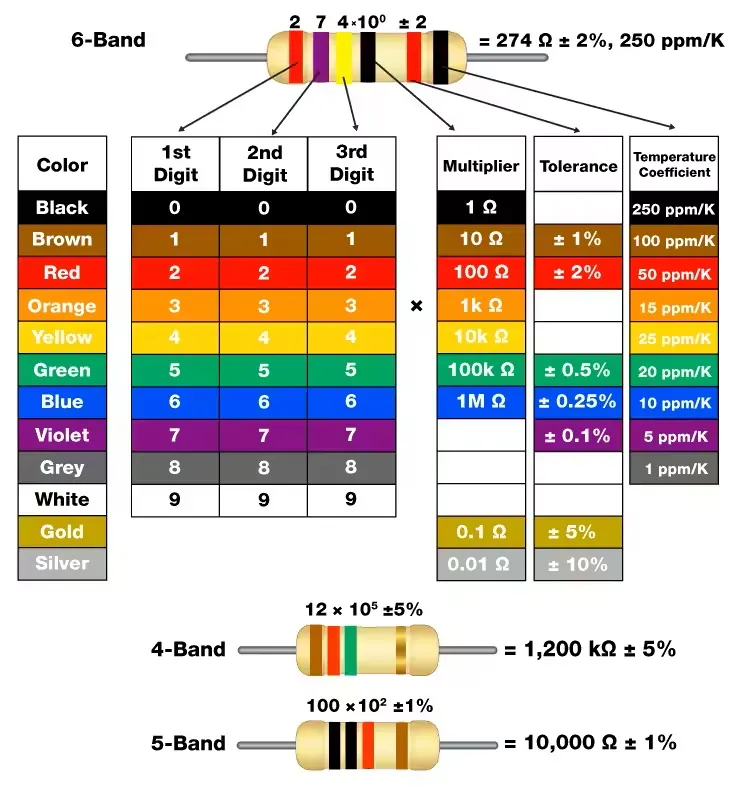
Among different specifications of resistors, the resistance value is an important one that indicates how effectively the resistor can regulate the electrical current. The key to knowing this value lies behind different color bands on it, which may exist in 4, 5, and even 6 bands.
Then, do you know how to read color bands on resistors? What's the meaning of each color band? In this article, AIChipLink will present you with a thorough guide to help you master the resistor color code!
Overview of the Resistor Color Code

The resistor color code is a universal system that uses colored bands to represent the resistor value and even the tolerance and the temperature coefficient. Each band corresponds to a specific digit or multiplier that indicates specific information. This can be convenient for you to decode the information you need once you master the techniques on how to read the color code on a resistor, as the table below illustrates.
|
How to memorize |
Color |
Significant digits |
Multiplier |
Temperature coefficient |
Fail rate | |
|
Bad |
Black |
0 |
×1 Ω |
|
250 ppm/K |
|
|
Beer |
Brown |
1 |
×10 Ω |
± 1% |
100 ppm/K |
1% |
|
Rots |
Red |
2 |
×100 Ω |
± 2% |
50 ppm/K |
0.1% |
|
Our |
Orange |
3 |
×1k Ω |
± 3% |
15 ppm/K |
0.01% |
|
Young |
Yellow |
4 |
×10k Ω |
± 4% |
25 ppm/K |
0.001% |
|
Guts |
Green |
5 |
×100k Ω |
± 0.5% |
20 ppm/K |
|
|
But |
Blue |
6 |
×1M Ω |
± 0.25% |
10 ppm/K |
|
|
Vodka |
Violet |
7 |
×10M Ω |
± 0.1% |
5 ppm/K |
|
|
Goes |
Gray |
8 |
×100M Ω |
± 0.05% |
1 ppm/K |
|
|
Well |
White |
9 |
×1G Ω |
|
|
|
|
Get |
Gold |
|
× 0.1Ω |
± 5% |
|
|
|
Some! |
Silver |
|
× 0.01Ω |
± 10% |
|
|
How to Read Color Bands on Resistors
1. How to Read a Resistor with 4 Bands
A 4-band resistor is the most common type, representing the resistor's value and tolerance. The first two bands indicate the significant values, the third band expresses the multiplying factor, and the fourth band indicates the tolerance. For example, a resistor with red, violet, yellow, and gold bands would have a resistance of 270 kΩ ±5% (red = 2, violet = 7, yellow = 10^4, gold = ±5% tolerance).
2. How to Read a Resistor with 5 Bands
A 5-band resistor is used for precision resistors and includes an additional band for temperature coefficient. The first three bands represent the significant values, the fourth band tells the multiplier, and the fifth band indicates the tolerance. For instance, a resistor with green, blue, black, red, and brown bands would have a resistance of 56 kΩ ±1% (green = 5, blue = 6, black = 0, red = 10^2, brown = ±1% tolerance).
3. How to Read a Resistor with 6 Bands
A 6-band resistor is less common and is used for high-precision applications. Compared to 5-band resistors, it includes one additional band for the temperature coefficient. The first three bands are the significant digits, the fourth is the multiplier, the fifth indicates the tolerance, and the sixth tells the temperature coefficient. For example, a resistor with orange, orange, black, black, brown, and brown bands would have a resistance of 330 Ω with a tolerance of ±1% and a temperature coefficient of 100 ppm/K.

FAQs about the Resistor Color Code/Bands
In addition to how to read color bands on resistors, this section will improve your understanding of the resistor color code by figuring out some FAQs.
1. What does the single black band on a resistor mean?
A resistor with one single black band means that this resistor is a zero-ohm resistor. It is essentially a conductive path that directly connects two points or traces on a printed circuit board (PCB) with approximately zero resistance. The same package as a standard resistor facilitates the assembly process by enabling the use of the same automatic machines to place the zero-ohm resistors on a PCB.
2. Why is there no gold or silver band on high-voltage resistors?
High-voltage resistors may not have gold or silver bands. Instead, yellow and gray bands are used to avoid having metal particles on their outer coatings.
3. What is the reliability band?
The reliability band is an additional band found on some precision resistors, typically 4-band resistors. It indicates the reliability of the resistor, specifically the failure rate (%) per 1000 hours of service. Often, it is used in military applications where long-term stability is critical.
Conclusion
Here, you may have a full grasp of how to read color bands on resistors. Whether you're designing a circuit or troubleshooting an existing one, knowing the resistor's specifications is key.
AIChipLink offers a wide range of electronic components, including different types of resistors, and has rich experience in electronic component sourcing and distribution. If you are having problems finding the right electronic parts, contact AIChipLink to let our professional team help you. At AIChipLink, we can offer you authentic, high-quality, and diverse electronic component choices!